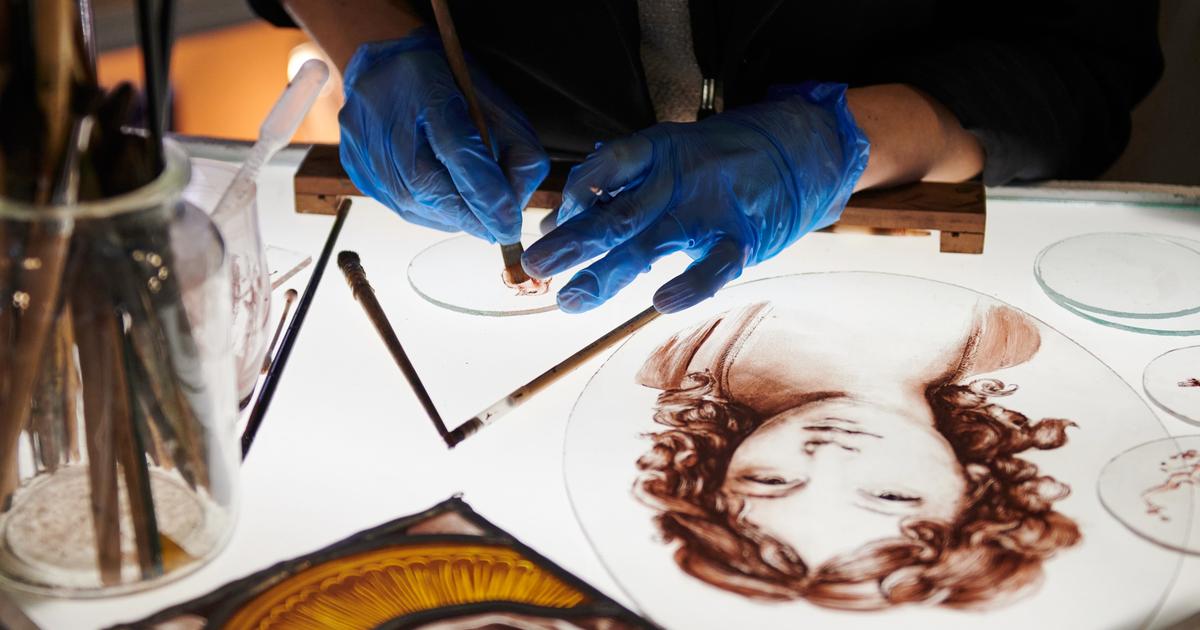The event, which is celebrating its 30th anniversary, is being held until Sunday at the Carrousel du Louvre in Paris. Among the 300 exhibitors, some stand out for the uniqueness of their profession.
The Carrousel du Louvre looks like a giant workshop on the opening day of the International Cultural Heritage Exhibition. In the exhibition rooms, a few dozen meters from the Louvre pyramid – a masterpiece by architect Leo Ming Pei -, the hands of artisans, the builders of tomorrow, suppliers of raw materials, architects or even conservation associations.
In the aisles of the show, construction giants, such as Vinci Construction and Vicat, are there and demonstrate their involvement on monumental projects. The renovation of Notre-Dame once again offers a beautiful showcase. Like Vinci Construction, whose subsidiary Bourgeois participated this year in lead roofing work on the restoration site of Notre-Dame Cathedral. But Stéphane Galerneau, president of Ateliers d’Art de France, organizer of the show, emphasizes that « 80% of French cultural heritage is private » and owned by nearly 20,000 owners. French cultural heritage is not limited to the monuments that populate the collective imagination. It also extends to more discreet treasures, which are based on extremely rare know-how.
Know-how since « primitive man »
Fanny Litzia’s stand, decorated with decorations made of colorful bird feathers, catches the eye of a group of curious people. « Each feather is different, which makes each of my creations unique »explains the feather worker. « This profession is one of the 281 art professions »listed by the Institute for French know-how. With her commercial flair, the designer is trying to tame some future clients. Behind her is one of her creations, prominently displayed on her stand. Three panels which form a square of one meter on each side. On its internet, the part is displayed at the price of 6650 euros. « Take my card »she insists. Fanny Litzia is one of around a hundred people who work as a feather worker.
This know-how has been perpetuated since « primitive man. « The golden age of the profession is the 19the century, she explains. At that time, women wore hats with feathers. After the Second World War, the profession almost disappeared. It is thanks to haute couture that the profession of feather worker has reappeared ». After creating her own samba costumes, Fanny Litzia finally chose to « develop a world of feathers in interior decorations ». A logical development for someone who is delighted to work in an atypical profession, after a first career in the socio-educational field.
At the heart of the Delorme room, Olivier Pineau does not wait to be reminded of the singularity of his know-how. Two workshops in France are recognized as restorers of old bladed weapons, including his own. Its stand, one of the most imposing, is one of the show’s must-sees. Among its exhibition models: a magnificent air force officer’s dagger from 1954, freshly restored. Solicited from all sides, the artisan struggles to calmly finish his sandwich. But nothing to sharpen his ego.
This former boilermaker in the Air Force is not so used to the spotlight. He restores old hussar or soldier sabers under Napoleon III in complete privacy, in the garage of his house near Reims. « I have 300 years of history on my workbench »he declares, with a smile on his lips. Its only competitor is none other than the Republican Guard armory. They only deal with weapons having a direct link with military institutions. So when a young man asks him for information on the restoration of a German saber that he inherited from his great-grandfather, Olivier Pineau is already planning a future project. « Are you over 18? »he asks. « Oui »replies the young man. « You send me an email with some photos and we’ll see what we can do. ». His agenda is already full until 2025.
« Restoring an antique piano can cost the price of a car. »
Sylvie Fouanon, old piano restorer.
A full order book does not always mean wealth in the bank account. The old piano restorer, Sylvie Fouanon, appointed Master of Art in October 2019 by the Ministry of Culture, is worried about not having the funds necessary to last during the long months that certain projects last. « Restoring an antique piano can cost the price of a car. So when I ask clients for a 50% deposit they balk »she says. On display at the Maison Balleron stand is an Erard piano from 1903, “zero” model, Adams style. Price: 54,000 euros.
Sylvie Fouanon
But these accounting concerns are nothing compared to those that cloud the future. Sylvie Fouanon deplores the lack of interest of younger generations in cultural heritage. « I collect a lot of old pianos from elderly people because the children don’t want to restore them. Others end up in the trash »she regrets. For Stéphane Galerneau, president of the show, it is necessary to « work on the promotion of artistic professions, on the education of young people in heritage professions.” He continues by highlighting the ecological dimension of heritage restoration with a motto that is up to date: « we recycle, we don’t throw away ».
The arrival on her stand of Robin Gallois, 29 years old and looking for a job in the restoration of old pianos, will disabuse her. After six years of study at the National Training Center for Apprentice Organ Makers in Eschau (Alsace), the young man struggled to find a job. He was forced to leave one of the last organ factories in Île-de-France due to its closure. « If I can’t find a job, the solution could be to open a self-employed business, but you need funds to open a premises. Otherwise I will go to work in furniture restoration », explains the young man. With contagious enthusiasm, here is someone determined to embody the future of craftsmanship.
